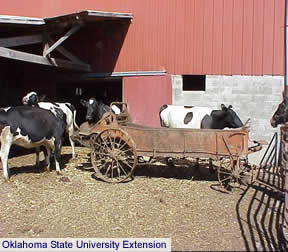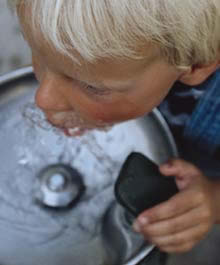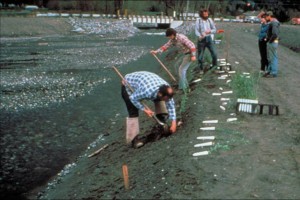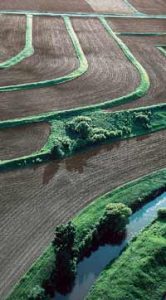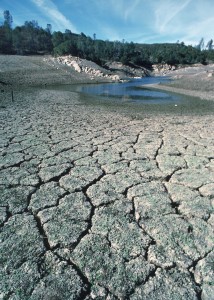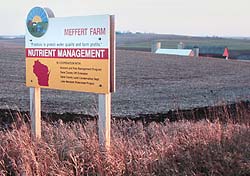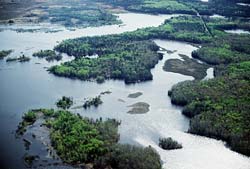What web resources will help me?
Education materials and resources for specific water management topics and issues
The water management education resource collection lists and describes educational resources that have proved useful to various target audiences. These resources were developed prior to 2012, and may not be available to view, but are described here as an example.
Resources were developed by Extension professionals to provide information to outreach audiences. Extension water quality specialists reviewed materials and resources prior to submitting to this on-line library, now an archived listing. The collection includes materials, case studies and professional development opportunities.
For topics and topic descriptions
For more about what kind of information is included in the description of each resource, see water management resource collection details
For help in deciding which examples may be useful to you, materials are organized according to eight water management topics listed here, and further described below. These topics were identified through a national dialogue among University Extension water quality professionals
Topics and short descriptions
- Animal Waste Management
- Drinking Water and Human Health
- Environmental Restoration
- Nutrient and Pesticide Management
- Pollution Assessment and Prevention
- Water Conservation and Agricultural Water Management
- Water Policy and Economics
- Watershed Management
Water management topics and issues:
Animal Waste Management
Animal waste from farms and ranches can severely threaten water quality if not managed properly. Animal waste from the 1.3 million farms with livestock and poultry (U.S. EPA estimate) across the nation has the potential to contribute excess nutrients, pathogens, organic matter, solids, and odorous compounds to the environment. This pollution causes eutrophication of surface waters, degradation of ground water quality, and threats to human health. Incorporating best education practices in your outreach with farmers or ranchers will maximize your animal waste management strategies to enhance water quality.
View animal waste management resource examples.
Adapted from the USA Water Quality Animal Waste Management Theme page, http://www.usawaterquality.org/themes/animal/default.html
Drinking Water and Human Health
The health and livelihood of Americans depends on the availability of a safe drinking water supply. In some portions of the nation drinking water is a scarce resource, while in other areas abundant water supplies are available. Community water systems now supply drinking water to over 80 percent of the U.S. population. Other citizens drink water from private sources, mostly wells. Increasing water demands from a growing population, economic expansion and increasing use per capita mean that we need to emphasize the wise use, proper management and protection of this resource.
Both community and private sources of drinking water are susceptible to a myriad of chemical contaminants, biological pollutants and nuisance water problems that may vary depending on site conditions and other factors. Some of the more common chemical pollutants include pesticides, fertilizers, petroleum products, and industrial solvents. Some problem organisms, including viruses, bacteria, protozoa and algae, cause nuisance problems with taste and odor while others are potential pathogens. Threats to drinking water quality come from animal and plant production agriculture, industrial activities and even activities around our businesses, residences, recreational areas and transportation systems. Many U.S. citizens are becoming more concerned about potential health risks and nuisance problems associated with their drinking water.
View drinking water and human health resource examples.
Adapted from the USA Water Quality Drinking Water and Human Health Theme page, http://www.usawaterquality.org/themes/health/default.html
Environmental Restoration
In our efforts to domesticate our lands and waters to the benefit of man, we have inadvertently degraded their ability to provide other uses. For example, by altering riparian areas and wetlands, we have affected their ability to provide fish and wildlife habitat as well as provide stream bank stability, flood protection and water quality protection. Environmental restoration tactics provide a means for remediating affected areas so they are able to resume their former roles in the water cycle of their community.
View environmental restoration resource examples.
Adapted from the USA Water Quality Environmental Restoration Theme page, http://www.usawaterquality.org/themes/restoration/default.htm
Nutrient and Pesticide Management
Nutrients and pesticides are potential pollutants of both surface and ground water. Pesticide and nutrient (fertilizer) use is almost ubiquitous across our developed and agricultural landscapes. Nutrients originate from a variety of sources including organic and inorganic fertilizers, plant parts, animal manures and human wastes. Likewise, pesticides are used for a wide range of purposes from disease, weed, and insect control in agricultural production systems to control of pests in urban lawns and landscapes.
Proper handling, use, and disposal of these important and beneficial products is critical for preventing adverse impacts on water resources and aquatic habitats. In order to provide larger harvests of affordable foods, farmers often supply crops with proper nutrients (fertilizers) and protect them from pests by applying pesticides. In maintaining their landscapes, homeowners tend to use proportionately more fertilizers and pesticides than do farmers and frequently have less training in proper application methods. Human and animal health problems can occur through excessive exposure to landscape and farm chemicals. Environmental pollution can occur when these chemicals enter waterways and groundwater systems. Nutrients and pesticides can enter surface and ground waters through misapplication, movement of treated soils, return irrigation flows, runoff from agricultural fields, stormwater runoff and leaching through soils. Groundwater contamination from pesticides and nutrients is a difficult long-term issue due to the impracticality of cleansing groundwater aquifers. Agricultural producers and homeowners should employ methods to assure proper application of chemicals to minimize potential exposure to people, animals, and the environment.
Adapted from the USA Water Quality Nutrient and Pesticide Managment Theme page, http://www.usawaterquality.org/themes/npm/default.html
Archiving in process
Pollution Assessment and Prevention
Water pollution is caused when contaminants wash into streams, lakes, wetlands or infiltrate into groundwater. Water running off paved surfaces in urban areas often carry oil, heavy metals, pet waste, and toxic chemicals from industrial and residential areas into stormdrains, and eventually, water ways. Agricultural operations often apply fertilizers, pesticides, and animal wastes, the excess of may eventually leach into groundwater or enter waterways through irrigation return flows and surface runoff. These sources of “nonpoint” pollution are considered the primary source of water quality problems nation wide.
Adapted from the USA Water Quality the Pollution Assessment and Prevention Theme page, http://www.usawaterquality.org/themes/pollution/default.html
Archiving in process
Water Conservation and Agricultural Water Management
For most Americans, poor quality water has never been a concern. However, with the beginning of the 21st century, many communities are facing diminishing water supplies and growing competition for the resource. Many lakes and reservoirs throughout the country are at historically low levels. Causes for diminishing water supplies are varied.
Socio-geographic changes in population are placing increased demands on water resources. Population growth is occurring where municipal and industrial demands are already great. Much of the increased demand is occurring in arid regions where water is always scarce. Water resources become even less dependable in years of drought. As water bodies become depleted, water quality decreases due to higher concentrations of chemical, biological, and physical contaminants. Numbers of intra and inter-state controversies are emerging as a result of water shortages.
Agricultural water management becomes increasingly important in the presence of low water supplies because it is usually when consumption by agricultural operations is examined more closely by their respective communities. When agricultural operations are able to incorporate more efficient methods of using water, a greater quantity of drinking water is made available for use by the community at large.
Adapted from the USA Water Quality Water Conservation and Agricultural Water Management Theme page: http://www.usawaterquality.org/themes/conservation/default.html
Archiving in process
Water Policy and Economics
The Nation’s rivers, lakes, and groundwater sources provide water for industry, agriculture, residential uses and recreation, as well as support a diversity of ecosystems. Increased demands from an expanding population, industrial growth, increases in agricultural production and ecosystem management have resulted in localized, temporal shortages of available water. Agriculture is the single largest water user. Effective water management will work with agricultural interests to address the replacement of inefficient irrigation methods by modern science-based water saving techniques, efficient nutrient and pesticide application, and strategic implementation of run-off controls.
Adapted from the USA Water Quality Water Policy and Economics Theme page: http://www.usawaterquality.org/themes/policy/default.html
Archiving in process
Watershed Management
Watershed level management requires a perspective that unites social, economic, and environmental concerns in a landscape where upland forests and rangeland, wetlands, agricultural and urban areas are integrated. An understanding of watershed linkages allows us to design long-term and sustainable solutions to a variety of natural resource problems. Model efforts in watershed management include the capture, storage, and safe release of water resources, the prevention and management of accelerated soil erosion through the maintenance of an appropriate vegetation cover, and prevention strategies for stormwater degradation of surface and ground water resources.
Watershed councils and planning groups act as decision support systems in local watershed management efforts. These groups bring stakeholders together to develop plans that consider all interests.
Adapted from the USA Water Quality Watershed Management Theme page: http://www.usawaterquality.org/themes/watershed/default.html
Archiving in process
Other resources:
Youth Water Education Resources
Search Target Audience Research
Search the National Agricultural Library
